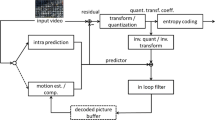Abstract
This paper proposes a multiple description (MD) mesh-based motion coding method, which generates two descriptions for mesh-based motion by subsampling the nodes of a right-angled triangular mesh and dividing them into two groups. Motion vectors associated with the mesh nodes in each group are transmitted over distinct channels. With the nodes in each group, two other regular triangular meshes besides the original one can be constructed, and three different prediction images can be reconstructed according to descriptions available. The proposed MD mesh-based motion coding method is then combined with the pairwise correlating transform (PCT), and a complete MD video coding scheme is proposed. Further measures are taken to reduce the mismatch between the encoder and decoder that occurs when only one description is received and the decoder reconstruction is different from the encoder. The performance of the proposed scheme is evaluated using computer simulations, and the results show, compared to Reibman’s MD transform coding (MDTC) method, the proposed scheme achieves better redundancy rate distortion (RRD) performance. In packet loss scenario, the proposed scheme outperforms the MDTC method.
Similar content being viewed by others
References
Vaishampayan V. Design of multiple description scalar quantizers. IEEE Trans. Info. Theory, 1993, 39(3): 821–834.
Vaishampayan V, John S. Interframe balanced multiple description video compression. In Proc. Packet Video, New York, April 26–27, 1999, pp.812–816.
Wang Y, Orchard M T, Reibman A R. Multiple description image coding for noisy channels by pairing transform coefficients. In Proc. IEEE Workshop on Multimedia Sig. Proc., Princeton, NJ, June 23–25, 1997, pp.419–424.
Reibman A R, Jafarkhani H, Wang Y, Orchard M T. Multiple description coding for video using motion compensated prediction. IEEE Trans. Circuits Syst. for Video Technology, 2002, 12(3): 193–204.
Kim C S, Lee S U. Multiple description motion coding algorithm for robust video transmission. In IEEE Int. Symp. Circuits and Syst., Geneva, Switzerland, May 28–31, 2000, pp.717–720.
Nakaya Y, Harashima H. Motion compensation based on spatial transformations. IEEE Trans. Circuits and Systems for Video Technology, 1994, 4(3): 339–356.
ISO/IEC 14496-2:2001. Coding of audio-visual objects—Part 2: Visual. Sydney, July 2001.
Wenger S. Error patterns for Internet experiments. ITU Telecommunications Standardization Sector, Document Q15-I-16r1, Red Bank, NJ, October 1999.
ISO/IEC JTC1/SC29/WG11 N3908. MPEG-4 video verification model version 18.0. Pisa, January 2001.
Author information
Authors and Affiliations
Corresponding author
Additional information
Supported by the National Natural Science Foundation of China under Grant No.60272050.
Rights and permissions
About this article
Cite this article
Wang, YL., Wu, CK. Complete Multiple Description Mesh-Based Video Coding Scheme and Its Performance. J Comput Sci Technol 20, 426–431 (2005). https://doi.org/10.1007/s11390-005-0426-1
Received:
Revised:
Issue Date:
DOI: https://doi.org/10.1007/s11390-005-0426-1




